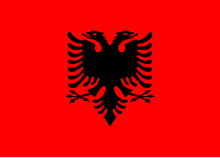Himni i Flamurit
| English: Hymn to the Flag | |
|---|---|
 |
|
|
National anthem of |
|
| Lyrics | Asdreni, 1912 |
| Music | Ciprian Porumbescu |
| Adopted | 1912 |
| Music sample | |
|
|
|
Himni i Flamurit (English: Hymn to the Flag) is the national anthem of Albania. The music of the anthem was adapted from an original composition by the Romanian composer Ciprian Porumbescu, for the song "Pe-al nostru steag e scris Unire" (or "E scris pe tricolor unire"). Whereas the words were written by the Albanian poet Asdreni (Aleksandër Stavre Drenova), and are merely different from the original Romanian lyrics which Andrei Barseanu wrote for Porumbescu's piece.
The hymn was first published as a poem in Liri e Shqipërisë (in English: Freedom of Albania), an Albanian newspaper in Sofia, Bulgaria, on April 21, 1912. The original title of the poem was "Betimi mi flamur," ("The Pledge on the Flag"). It was later printed in a volume of poems by Drenova titled Ëndra e lotë (in English: Dreams and tears), which was published in Bucharest. According to Lasgush Poradeci's memoirs, the anthem, created by the adaptation of the text to the music, was not originally intended to be a national anthem, yet, it was so much liked from people that it was proclaimed as the national anthem in 1912, and it was under its music that the Albanian flag was raised during the Albanian Proclamation of Independence in 1912 in Vlore, Albania.
According to Hungarian musicologist György Ligeti, the music, composed by Porumbescu, is deeply rooted in Germanic and Austrian musical traditions, and very similar to mid 19th century Germanic songs. This is also explained by Porumbescu's musical formation, since he had studied at the University of Music and Performing Arts, Vienna. The view has been shared by Albanian musicologist, Ramadan Sokoli.
There are two versions of the anthem: a long and a short one. Below is the text for the long version. The second stanza is considered as refrain and is repeated at the end. The short version makes use of the first two stanzas only and repeats the last two verses of the 2nd stanza. Usually, in sportive events among national teams, the short version is the one officially used. (The original poem has three more stanzas that are not part of the anthem – which are added at the end.)
...
Wikipedia
